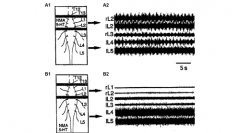

 Comptes Rendus Palevol
5 (3-4) - Pages 667-674
Comptes Rendus Palevol
5 (3-4) - Pages 667-674The fundamental evolutionary change in Vertebrate locomotion that allowed the transformation from aquatic swimming to overground stepping was related to a substantial reshaping of locomotor rhythm generating circuits located at the spinal cord level. The metameric organization of rhythm genesis in the lamprey, for example, evolved into neuronal pattern-generators re-centred at C7–T1 and L1–L2 spinal levels that are responsible for driving limb locomotor movements in quadrupeds such as the rat and rabbit. In Mammals, further locomotor adaptations such as the hopping hindlimb coordination in the rabbit, which is morphologically related to hindlimb lengthening, is achieved by a supraspinal reconfiguration of the basic alternate coupling of the bilateral lumbar locomotor generators found in all studied Mammals, including the rabbit. In this way therefore, evolution and behavioural adaptation of locomotion may involve utilisation of different neural mechanisms.
Evolution, Adaptation, Locomotor networks